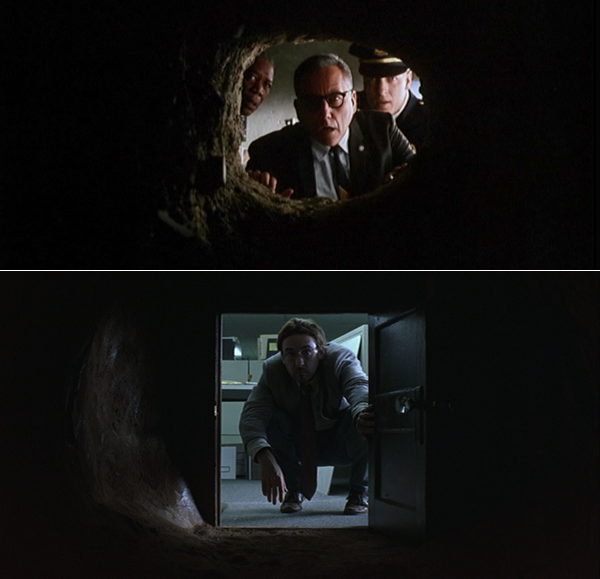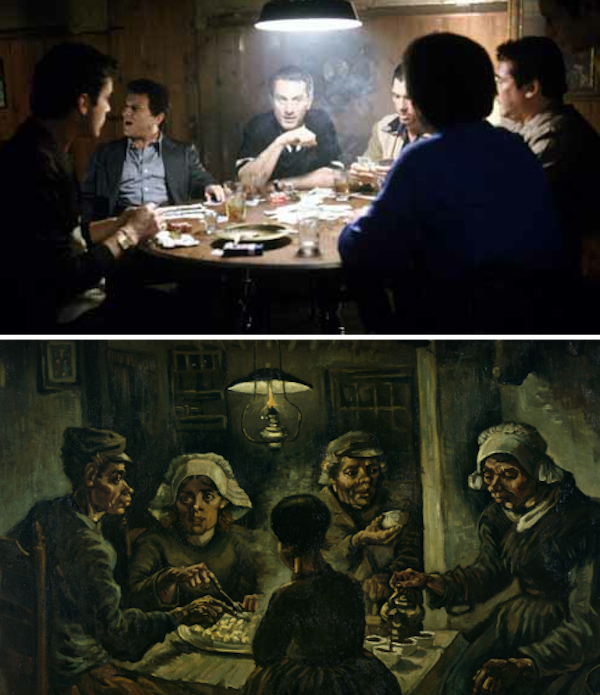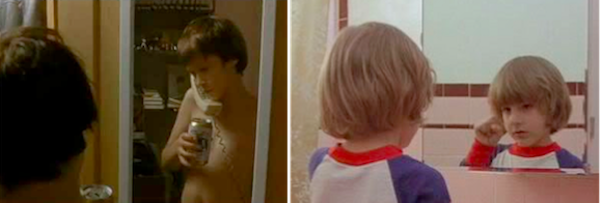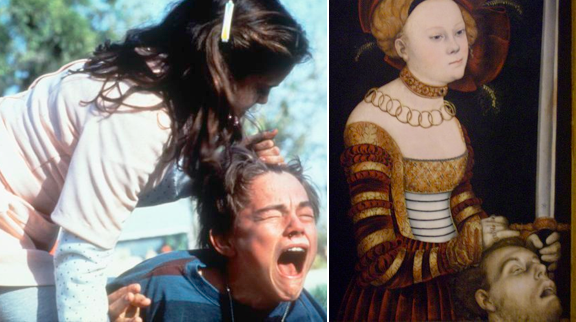Film
Movie Potpourri

I.
In “Encore,” (Book XX, Seminar, 1972) Jacques Lacan claims that St. Teresa is coming in Bernini’s Ecstasy of Saint Teresa (1652) — one may imagine his soft pink academic finger placed right on it — which seems post-whateverly reasonable after reading the subject’s autobiography, in which she states “I saw in his hand a long spear of gold, and at the iron’s point there seemed to be a little fire. He appeared to me to be thrusting it at times into my heart, and to pierce my very entrails; when he drew it out, he seemed to draw them out also, and to leave me all on fire with a great love of God. The pain was so great, that it made me moan.” Which all seems mild when you consider how close-ups on the weeping Virgin Mary’s tears seem like misdirected facials, or the clitoral countenance of all those emanant halos. This of course, may just be the torrent of my head. Lacan says “the habit loves the monk,” a playful adaption of l’habit ne fait pas le moine (“the habit does not make the monk”), which is a figurative way of saying appearances can be deceiving. The habit this monk loves is a shameful thing. A lesser Bernini, Rob Reiner has Meg Ryan fake it in When Harry Met Sally (1989), which confused my 13-year-old woody; didn’t know if it should stand at attention or smirk at the hip adultness, its severe almost hostile realism that women may have been faking it all the time. I’ve always found “I’m coming” — a partner’s bored face rendered invisible by the proclaimer’s eyelids — rather endearing: we are announcing our spiritual itinerary; that finally, after the chess match of texts, the avalanche of tiny drinks, the angry limbs of mutual cadence, we are hereby almost present.

II.
Perhaps the light at the end of the tunnel is not the cameras, but you — a judgmental God with his statistically curious finger on Rotten Tomatoes, in disbelief that the rest of the world agrees with him +/- 5% or so. Some of my lonelier weekends I open Netflix and Rotten Tomatoes next to each other, browsing the former and corroborating with the latter, promising myself to not watch anything rated under 60%. Mediocre taste is a liberating thing, as the snob’s work is tedious, all those awful films you try to like. I’d rather just watch an okay one and get it over with. I’ll check out the award winning classics, Ebert’s heyday thumb subconsciously replaced by his late-career chin, and sigh at all the first world romantic comedies and third world documentaries. The portal to John Malkovich, if seen under a spiritual lens as opposed to a postmodern one, is that of reincarnation — the infected and lowly POV despite, even antagonistic towards, the profane body. Christianity, Judaism, and Islam are all less keen on reincarnation, each preferring the posthumous eternal upgrade they fought so hard to be promised. It takes a Buddhist to concede, again and again, to this despicable world. If it’s raining on a Sunday afternoon, imprisoned under the softest exoskeleton of flab, wearing grey sweat pants, then Shawshank Redemption (1994) is likely to be on TBS. When Morgan Freeman starts narrating your porn you know you’ve seen the movie too many times. I love it when Andy Dufresne escapes, imagining myself walking into a small town with a new social security number and shoes; short of that, I can see why many desperate people become Born again, or wish to inhabit a celebrity’s mind. In real life, Andy Dufresne would just live out his Life prison sentence — the endless appeals, tax payer’s money, ass rape — or hang himself with the same rope he so metaphorically chained his ankle to his new life with.

III.
Bunch of bros write some wicked code on unconventional ad hoc surfaces, make chicks cry by being general dicks, turn down awesome think-tank jobs, and wind up in Palo Alto. Their narrative arcs are rather similar. The reoccurring story, or myth, of punk genius may be the subconscious legacy of Thomas Jefferson, conveniently also headed, eventually, toward the Pacific. There, we meet a girl in Stanford panties, the golden scintillating light of her bedroom a relief from the austere Bostonian sepia lens of Harvard bricks. Picture Einstein writing E=Mc² on a chalkboard and you’re wrong, ’tis actually Rᵢk=O2, his formula for the density of the universe. My dad wanted me to major in mathematics or computer science. He grimly spoke about the “real world” of mortgages and taxes, of future wives (plural, the cynic) and children. An untrusting rationalist, he believed the equal sign was more fair than emotional equality. I said I just wanted to be Picasso, and fantasized about starving in Paris and getting syphilis from someone who was worth it. Good Will Hunting (1997) ends with Will on the I-90 W en route to California, and it’s unclear if it’s him inside his car listening to Elliot Smith, or a contractual nod to the soundtrack. If video killed the radio star, then vimeo killed our attention span, and Netflix killed my social life. My grey sweat pants are a kind of ultra absorbent doiley. Would I want to get into an emotionally draining relationship with Meg Ryan, habitually holding a Kleenex box to her tears? Get some think-tank job in Palo Alto, silently judging my new friends in a bar on University Avenue? Be John Malkovich? Likely not, for surely I would not have time for a movie. As for Facebook co-founder Eduardo Saverin, whose rating algorithm — as heavily stylized in The Social Network (2010), a camera angle cordoning us off as voyeurs — launched this whole mess, his stocks were diluted and socks too, on Zuckerberg’s doorstep, the golden entrepreneurial light of unethical privacy practices marketed to a generation of histrionics now marked with rain, that timeless pop of erosion.

IV.
I have this creepy suspicion that being in a relationship with me is like having to know Joe Pesci in Goodfellas (1990), whose maniacal offense at the world could not be mollified with even murder. His character is based off Tommy DeSimone, a mob associate of the Lucchese crime family, who stood 6’2″ but was played by the much shorter Pesci in order to convey an inferiority complex. Small guys wouldn’t have such a big problem if everybody wasn’t so mean about it. The painting of the man and two dogs on a boat featured in the film has been copied extensively by fans, which proves yet again that art triumphs over having way too much time. My dad, in a sobering response to my wanting to be a painter, said over the phone “you’re no Van Gogh,” which at first deeply offended me. I figure I’d cut off his ear and call it even. As years passed — the drab and dirty phthalo greens and blues still weather in my body, but now hungry and tired — I realized he was right, and am weirdly grateful to him. Thinking that one’s work matters will torture an artist and hold hostage their friends and loved ones for having to lie. Every relationship is a form of organized crime. Joe Pesci is shot in the head for shooting a boss in the face, the ying/yang of not-so-subltle karma doing its dance. Van Gogh’s pencil landscapes are the tapestry of light. The earnest hand, when loyal to God, becomes its own God, lending new followers a way. For The Potato Eaters (1885), his first “serious” work, Van Gogh purposely chose ugly models to depict peasants as they really were. The prostitutes he sketched were not exactly cuties either. Sometimes it helps to believe the lie that others are beautiful, including your son. The next time someone hands you a potato and tells you to hold still for an hour, tell him to fuck off. No one has time for a dreamer.

V.
Certain ’80s sitcoms (e.g. Charles in Charge, ALF, Mr. Belvedere, Who’s the Boss?) had this young boy written into the scripts, a kind of rogue son overshadowed by his more charming and precocious older sister(s). He’d pop in the kitchen occasionally, ingest a product placement, say a few lines, get spoken to in an ambivalent if not emotionally abusive way, then leave. He’d come back a few episodes later, barely liked. D.F. Wallace has explored the idea of the figurant in Cheers, extras in the background miming the gestures of conversation while saying nothing, whom he called “human scenery,” as a metaphor for childhood alienation. The rampant alcoholism in Cheers is misleading, for everyone remains charming. One of the best written boys in recent film is Frank (Owen Kline) in The Squid in the Whale (2005), whose journey into his parents’ divorce hilariously, and sadly, spun wildly out of control. Shirtless a la Lord of the Flies, he starts drinking beer, smearing his semen on spines at the public library, listlessly following each pathetic male role model in his life. Frank’s invisibility may reflect the more symbolically heavy-handed Danny in The Shining (1980), who supplies a less romantic psychiatric interpretation that both he and his father were simply schizophrenic. These little Robert De Niros stand in front of a mirror existentially asking then who the fuck are we talking to? Danny’s imaginary friend Tony (who lives inside his mouth) is argued among the more obsessed with the film to be his sexually abusive father’s penis. That each one of our lives is the extended tragic autobiography of our father’s load may explain how gross everything feels. I’m only offended that there wasn’t a laugh track around.

VI.
Michael Myers is a less interesting horror film villain than compared to his peers. In Halloween (1978), 6-year-old Michael Myers stabs his sister to death with a kitchen knife; he is committed, and fifteen years later he returns home crazy as ever, futilely chased by his psychiatrist waving a prescription for Thorazine and other pills young women flaunt on twitter today. Most horror film victims tend to be sexually promiscuous females with a penchant for substance abuse, and while their graphic punishments may seem didactic or moralistic, they are perhaps the standard quota for tits n’ ass, the supple product placement of humanity. They say women scream during sex to attract other competitor males, which is why I wear earplugs at night. Unlike more fantastical horror franchises (e.g. the magical realist Nightmare on Elm Street; the geographically abstract and improbable Hostel; a medieval Saw, an ironic Chucky, etc.) the Halloweens take place in suburbia (a fictional Haddonfield, Illinois), whose vicinity to home — with an odd touch of Kmart realism’s quietude — and quotidian drama renders each death possible. This possibility of it happening to the viewer oddly succeeds at literary realism in more ways than novels do, most aptly employed by the super fun and quite philosophical Final Destination series, whose intricately choreographed deaths are some of the smartest things around. In Vanilla Sky (2001), a disfigured Tom Cruise sarcastically goes to raves wearing a mask, convinced he will not find love. That our actor had not realized how such a mask inadvertently described such vapid and empty acting is both sweet and sad. A true maniac will ask for millions per movie, and slowly murder his audience. Tom’s apartment was a bro fantasy: a framed smashed guitar, hologram of Louis Armstrong, and a post-coital Cameron Diaz wrapped in sheets. He suffocates her, or not. It was a confusing movie.

VII.
Jacques-Louis David’s The Death of Marat (1793) was painted just months after French revolutionary leader Marat’s assassination by Charlotte Corday, a minor aristocrat who blamed him for the September Massacre in Paris the previous year. Marat had a skin ailment, which caused him to write in his bath. (One may consider Pierre Bonnard’s wife, an obsessive compulsive bather, as an apolitical descendent.) A lesser version of the event, painted by Paul Baudry in 1860, shows Charlotte as the subject of the painting, leaning against a wall away from the window. We all know the story behind the production of Apocalypse Now (1979), of insane drug use, severe weather destroying cameras and footage, and other logistical disasters, and the uncanny parallel journey up the river to Marlon Brando’s narratively inappropriate weight gain. Mistah Kurtz, he did. The mini-colonization of the film, its tactical failure and accidental truth, served as a lesson to many. No animals were hurt during the filming of this film, unless you consider the sacred cow that got its head hacked off. Martin Sheen was high when he improvised the actual breaking of a mirror with his fist, followed by a real life meltdown on film. His penis flipped and flopped, and I worried about the shards of broken glass. The film was senseless, which may be why it seems the most honest portrayal of the war in Vietnam. Many years later, his son Charlie Sheen would offer the public similar psychosis, albeit more comical, a stare into a video cam, clipped into a minute clip, the bloody contractual ink of Two and a Half Men somehow wiped away. He was fired on March 7, 2011, and announced a nationwide tour, of something.

VIII.
Girl power in effect, feisty widow Judith enters Holofernes’ room — a general invading her people — while he is sleeping off a night of drinking, and decapitates him. The event, accounted in the Book of Judith, is the subject of over a hundred paintings. Some of them show Holofernes’ head in a basket, some on a platter, or being held by his hair in the air, or whilst being cut off. Judith gave head to her people, followed by sighs of joy. On September 3, 2012, a Turkish woman decapitated her rapist and dumped his severed head in the village square, proclaiming “that is the head of the one who toyed with my honour”; “toyed” feels diminutive, considering the severity, though that may just be a question of translation. Five months pregnant with his child (he had been raping her for months), she said to authorities she was willing to die for an abortion, which is odd, since those things are mutually inclusive. Of course, she meant it on principle. In What’s Eating Gilbert Grape (1993), a disgruntled sister grabs Arnie’s (Leonardo DiCaprio) head by the hair with Judithian grip before getting a smack down from paternal brother Gilbert (Johnny Depp), who found love in a hopeless place. DiCaprio’s performance is ecstatic and endearing, the kind of full retard deserving of an Oscar. They burn their house down with a dead fat mother inside. Gilbert meets a traveling girl who promises to return. I’ve watched all of these movies a bunch of times, maybe half-a-dozen each, and sort regret the life I didn’t go out and make for myself. And yet, I have all these stories to tell. A movie is where you want to be, without the liability of living their lives. Gilbert Grape is one of my favorite. I watch it to this day, lying on my couch, eyes coursing over the KFC balanced on my chest, a chicken leg bone protruding outward like some Biblical rib, if only God would make someone else, pass the screen into a lent world, one frozen in the very movement it pretends to be, a frame at a time stacked as individual blinks, waiting with my retarded brother and gorgeous hair, and over the hills as my girl comes.

for christmas this year i got a reified love for the work of jimmy chen
now a major motion picture
I came.
This is good, Jimmy. You don’t need me to tell you this but you are doing great work.
This is brilliant
i don’t know that i wanted to know that about women calling to competitor males. that is some dark shit, science
“female macaque monkeys give a shout to help trigger their mates’ orgasm”
re: Ecstasy of Saint Teresa see Infinite Jest, Back Bay 10th anniversary paperback edition, pg 373